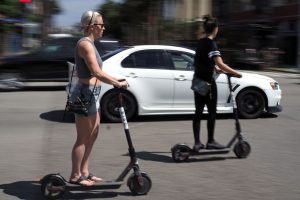A thirteen-year-old can use an electric scooter, but with specific regulations and parental supervision.
Understanding Electric Scooter Laws
Electric scooters have surged in popularity as an eco-friendly alternative to traditional transportation. However, with this rise comes the need for clear regulations to ensure safety and order on the streets.
Age Restrictions and Legal Requirements
Most regions have set the minimum age for electric scooter operation to 16, but some may allow younger individuals to ride with certain restrictions in place. For instance, a 13-year-old may be permitted to ride an electric scooter under the supervision of an adult or on private property. It’s crucial for riders and their guardians to be aware of the power output limitations as well; scooters for this age group typically must not exceed 250 watts to ensure manageable speeds.
When it comes to legal requirements, helmet usage is often non-negotiable. The law usually mandates that all riders, irrespective of age, wear helmets. Some regions might also require a valid license or permit, even for low-powered scooters.
Regional Differences in Electric Scooter Legislation
Electric scooter laws can vary greatly from one area to another. In some cities, these vehicles are welcomed in bike lanes and have designated parking areas, while others restrict their use to certain times of the day or specific zones. For example, urban areas might impose a speed limit of 15 mph, while suburban areas might allow for up to 20 mph, as long as the rider adheres to the traffic laws.
The cost associated with electric scooters can also be influenced by regional legislation. In some jurisdictions, there may be subsidies or incentives to encourage the use of electric scooters, affecting the overall affordability. Conversely, some areas might impose additional fees or require insurance, which can increase the total cost of ownership.
It’s essential for potential riders and their guardians to consult their local Department of Motor Vehicles or equivalent authority to get the most current and relevant information, which could include specifics on power, cost, efficiency, lifespan, and safety requirements. This ensures compliance with the law and maximizes the benefits of electric scooters as a sustainable mode of transportation.
Safety First: Electric Scooters and Teenagers
When it comes to teenagers riding electric scooters, safety is paramount.
Essential Safety Gear for Young Riders
Every young rider must equip themselves with a high-quality helmet. The helmet should meet safety standards such as those set by the Consumer Product Safety Commission (CPSC) and should fit snugly while allowing for visibility and hearing. Additional gear includes knee and elbow pads which should have a secure fit and provide ample protection without hindering movement. Reflective clothing or stickers are also vital, especially if the scooter is used during low-light conditions. The scooter itself should be equipped with lights and a bell for added safety.
When evaluating safety gear, parents and teenagers should consider factors such as material quality and durability. For example, helmets should be made of robust materials like ABS plastic or polycarbonate, with a lining of EPS foam to absorb impact. Prices for a good helmet can range from $30 to $100, and a full set of safety gear can cost upwards of $150, a worthwhile investment for safety.
Teaching Teens Safe Riding Habits
Education on safe riding habits is as crucial as wearing the right gear. Teens should learn the importance of obeying traffic laws, including riding with the flow of traffic, obeying traffic signals, and using hand signals when turning or stopping. Understanding the capabilities and limits of their electric scooters, such as maximum speed and how it performs on different terrains, is essential for safe operation. The average electric scooter for teenagers has a speed limit of approximately 15 mph to ensure control and safety.
Moreover, maintaining a scooter can teach teens responsibility while ensuring the ride remains safe. They should regularly check the tire pressure, brakes, and battery life. The lifespan of a scooter’s battery can be around 300 to 500 charge cycles, and keeping it properly charged can extend its usability and efficiency.
Choosing the Right Electric Scooter for a 13-Year-Old
Selecting an electric scooter for a teenager involves careful consideration of various specifications and features to ensure the scooter is safe, reliable, and enjoyable to ride.
Assessing Scooter Specifications and Features
When examining electric scooters, it’s essential to consider the motor power, which typically ranges from 200 to 350 watts for models suitable for younger teens. This power allows for a balanced speed that is safe for a 13-year-old, usually capping at 15 mph, which is sufficient for leisure riding and short commutes. The battery life is another critical factor, as it determines how far the scooter can travel on a single charge. Look for models offering a range of at least 5 to 10 miles, which should cover the daily needs of a young rider without frequent recharging.
The scooter’s brakes are a pivotal feature, with options including foot, drum, and disc brakes. Disc brakes are highly effective, but for a lightweight and less powerful scooter suitable for a 13-year-old, drum brakes can offer a reliable, low-maintenance choice. The cost of electric scooters with these specifications can vary, but a budget of $200 to $400 can typically secure a quality model that balances price with features.
For a deep dive into the specifics of electric scooters, parents and teens can consult the Wikipedia page on electric scooters which provides detailed information about different models and their specifications.
The Importance of Weight Limits and Scooter Size
The weight limit of an electric scooter is a specification not to overlook. Most youth scooters can accommodate riders up to 150 pounds, ensuring safety and optimal performance. Choosing a scooter that supports the teenager’s weight is crucial for maintaining the scooter’s structure and motor efficiency over time.
Scooter size, especially the deck size, is equally important. A deck that is too small can make the ride uncomfortable and unsafe, while one that is too large can be cumbersome for a 13-year-old to maneuver. A suitable deck size allows the rider to place their feet side by side comfortably. As for the overall dimensions, they should align with the rider’s height to ensure ease of control and balance. The material quality also plays a role in both safety and longevity; look for scooters made with aircraft-grade aluminum, which provides a good balance between durability and lightness.
Parental Guidance and Supervision
The role of parents in the use of electric scooters by teenagers is critical. It involves setting clear guidelines and actively monitoring their scooter activities to ensure safety and responsible use.
Setting Ground Rules for Scooter Use
It’s also vital to discuss the importance of not exceeding the scooter’s maximum speed, which is often around 15 mph for models suited to younger riders, to maintain control and safety. Moreover, parents should set rules about the number of riders on a scooter, typically one, to prevent overloading and potential accidents.
The Role of Parents in Monitoring Scooter Activities
Parents must actively engage in monitoring their teen’s scooter use. This might include periodic checks to ensure the scooter is in good working condition, which involves verifying the tire pressure, brake functionality, and battery levels. The lifespan of the scooter’s battery can be a significant factor in monitoring, as it typically lasts for 300 to 500 charge cycles, and proper charging practices can extend its life.
Furthermore, parents should encourage regular communication about the teen’s planned routes and destinations. This can involve using apps or devices that allow for GPS tracking of the scooter for added peace of mind. By staying informed about their teen’s scooter use, parents can support their independence while ensuring their safety.



